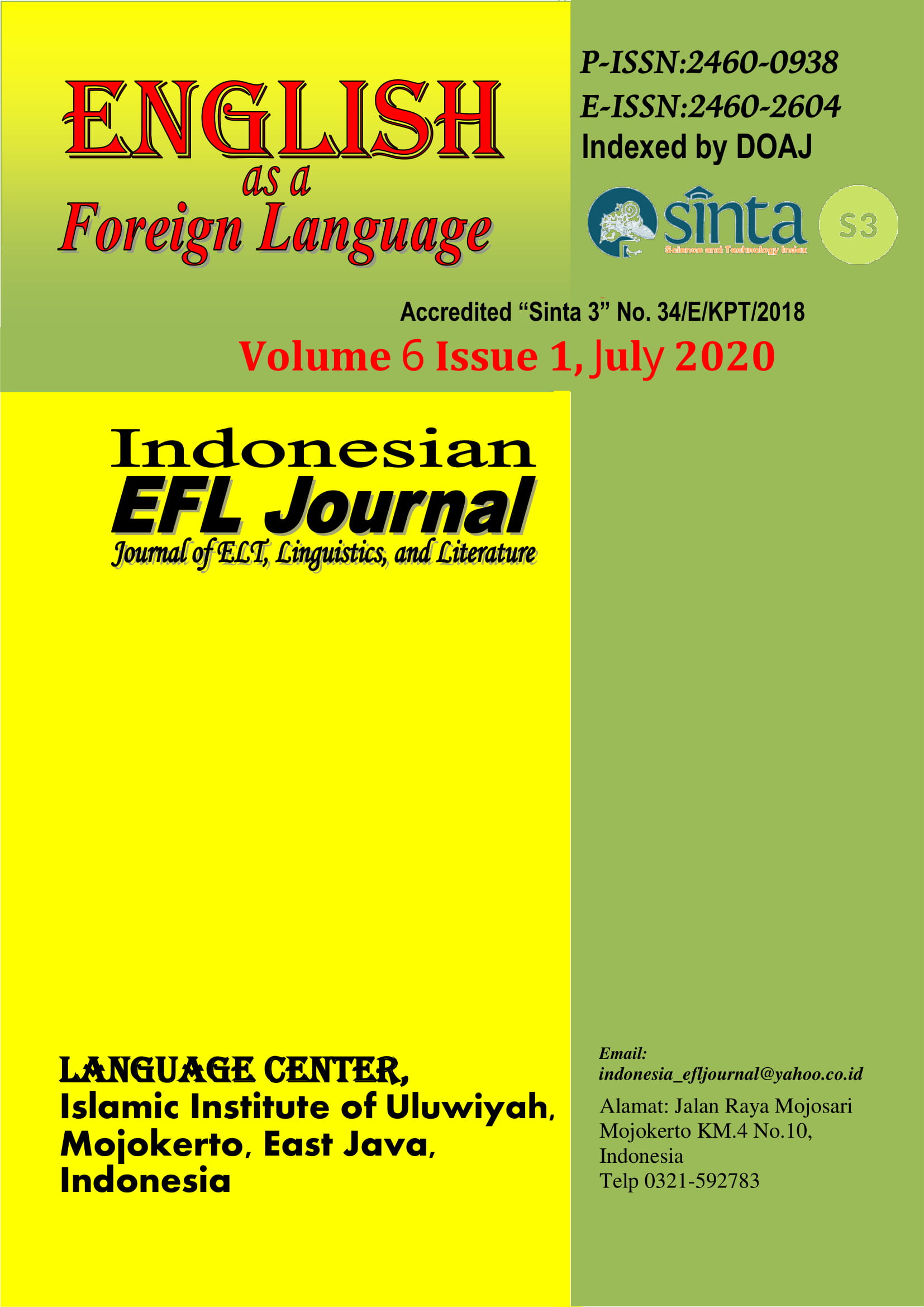Learning Writing by Paraphrasing the Quotations on SFL
Abstract
Writing is one of the language skills. Nevertheless, most EFL students got a problem with writing. It provokes their hindrance in learning English. The lack of vocabulary and competence in adapting grammar rules are the agent to worsen their writing ability. Comprehending the text is a kind of way to help the students build their vocabulary knowledge. The words they learn can be adapted to study grammar through GTM. They are essential to better their practical ability in descriptive text. It is the implementation of the SFL theory. Practicing descriptive text supported by adapting reading comprehension and GTM develops the students’ competence to paraphrase the text. Paraphrasing through SFL enhances writing skills.
References
Anderson, J. Charles. 2000. Assessing Reading. Cambridge: University Press.
Asl, E. H. (2015). Comparative study of grammar translation method (GTM) and communicative language teaching (CLT) in language teaching methodology. International journal of science and research methodology, vol. 1(3) 16-15.
Butt et al. (2003). Using functional grammar: an explorer’s guide. Sidney: National centre for English language teaching and research.
Durst, R. K. (1989). Monitoring processes in analytic and summary writing. Written
communication, 6(3), 340-363.
Grabe, W., &Stoller, F. L. (2002). Teaching and researching reading. Harlow: Pearson Education.
Halliday, M.A.K. (1978). Language as social semiotic: the social interpretation of language
and meaning. London: Edward Arnold.
Halliday, M. A. K. (1994). Introduction to functional grammar. In anintroduction to systemic functional grammar. Https://doi.org/doi: 10.1016/j.jfineco.2004.10.007
Halliday, M. A. K., &Matthiessen, C. M. I. M. (2004). An introduction to functional grammar (3rd ed). London: Hodder Arnold.
Hamilton, S. J. (2005). Development in reflective thinking. Retrieved October 19, 2009, from http://www.reap.ac.uk/reap07/portals/2/csl/trydy%20banta/development
Harmer, J. (2007). How to teach English. London: Pearson education limited.
Harmer, J. (2007), the practice of English language teaching. 4th ed. Harlow: Longman.
Hood, S. (2008). Linguistics and education: an international research journal, 19(4), 351-365.
Hornby, A.S. (1995). The advanced learner’s dictionary of current English. In advance learners’ dictionary of English.
Hung, D. M., &Ngan, V. P. T. (2015). Investigating reading strategies used by EFL students at Dong Thap University. Asianjournal of educational research, 3(4), 10-20.
Hidayat, Y. (2014). The ideational meaning realised in written discourse in online newspaper on Abdul QodirJaelani. English education journal, 25– 35.
Khan, A. B., &Mansoor, H. S. (2016). The effectiveness of grammar translation method in teaching and learning of English language at intermediate level. International journal of institutional &industrial research, vol 1 (1) 22-25.
Knapp, P., & Watkins, M. (2005). Genre, text, grammar. Sydney: university of New South Wales press ltd.
Latrobe University. (2010). Referencing and paraphrasing(how to avoid plagiarism). Retrieved on May 4, 2011, from http://www.lib.latrobe.edu.au /help/ste-referencing-guide- 2010.pdf
Lili, Z. (2014). A discussion of linguistic factors relating to English reading for Chinese Mongolian students. Studies in literature andlanguage, 9(3), 136-142.
Masniyah. (2017). The use of paraphrasing strategy to improve the students’ writing ability at the 2nd year students of SMAN 1 Tinambung. English education department (thesis). Tarbiyah and teaching science faculty Alauddin State Islamic University Makassar. Derived from http://repositori.uin-alauddin.ac.id/4914/1/masniyah_20400113134.pdf
Martin, J. R. (2009). Genre and language learning: a social semiotic perspective. Linguistics and education, 20(1), 10-21. Doi:10.1016/j.linged.2009.01.003
Maximo, R. (2000). Effects if rote, context, keyword, and context/ keyword method onretention of vocabulary in EFL classroom, language learning, 50, 2, 385-412.
Mcnamara, D. S. (2007). Readingcomprehension strategies:theories, interventions, and
technologies [electronic version]. New Jersey: Lawrence Erlbaum associates, Inc.
MIT academic integrity. (2010). Avoiding plagiarism:paraphrasing. Retrieved on March 25, 2011, from http://web.mit.edu/academici ntegrity/ plagiarism/paraphrasing.html
Nation, I. S. P. (2001).learning vocabulary in another language. Cambridge: Cambridge university press.
Nordquist, R. "overview of systemic functional linguistics." Thoughtco, Feb 11, 2020, thoughtco.com/systemic-functional-linguistics-1692022.
Orellana, M. F., &Reynol, J. F. (2008). Cultural modeling: leveraging bilingual skills for school paraphrasing tasks. Reading research quarterly, 43(1), 48-65.
Oshima, A and Hogue, A. 2007.Introduction to Academic Writing. New York: Person Education, Inc.Pearce, M. The Routledge dictionary of English language studies. Routledge, 2007.
Ramazani, C. B. 2006. Writing aparaphrase. Saint Michael's college. Retrieved on April 21, 2009. From http://academics.smcvt.edu/cbauer ramazani/ aep/en104/paraphrase.htm.
Reid, Joy M. (1988). The Process ofComposition. Englewood Cliffs, New Jersey: Prentice HallRegents.
Samad, I. A.,Jjannah, M., and Fitriani, S. S. (2017). EFL students' strategies dealing with common difficulties in TOEFL reading comprehension section. International journal of languageeducation, 1(1), 29-36.
Seidlhofer, B. (2011). Understanding English as a lingua franca. Oxford: Oxford university press.
Shokrpour, N. &Fallahzadeh, M.H. (2007). Survey of the students and interns’ EFL writing problemsin Shiraz University of medical sciences. The Asian EFL journal quarterly march 2007 volume9, issue 1, p. 147-163.
Sweet, A. P., & snow, C. E. (2003). Rethinking readingcomprehension. New York: Guilford press.
Thompson, G. (2014). Introducing functional grammar (3rd ed.). New York: Routledge.
Thorburry, S. (2002).how to teach vocabulary.England: Pearson education limited.
Ur, p., (1998). A course in language teaching.Cambridge University press.
Walters, J.M. (2004) 'teaching the use of context to infer meaning: a longitudinal survey of L1 and L2 vocabulary research'. Language teaching, 37(4), pp. 243-252.
Wette, R. (2010). Evaluating student learning in a university-level EAP unit on writing using sources. Journal of second language writing, 19(3), 158-177. Https://doi.org/10.1016/j.jslw.2010.06.002
Yukselir, C. (2014). An investigation into the reading strategy use of EFL prep-class students. Social and behavioral sciences journal, 158, 65–72.
Copyright (c) 2020 Indonesian EFL Journal: Journal of ELT, Linguistics, and Literature

This work is licensed under a Creative Commons Attribution-ShareAlike 4.0 International License.
All rights reserved.
this publication may be reproduced, stored in a retrieval system, or transmitted
in any form or by any means, electronic, mechanical, photocopying, recording.




